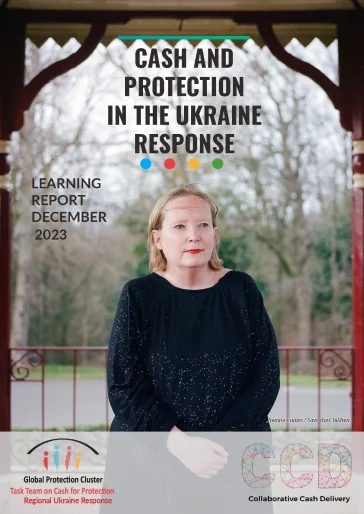Cash and Protection in the Ukraine Response
This learning report stems from bilateral discussions with the Collaborative Cash Delivery (CCD) Network’s members in Ukraine and Poland, many of whom were on the cusp of designing or implementing C4P programmes as part of the Ukraine response and were seeking learning and experience from each other.
Together with the Regional C4PTF, it was agreed to commission this learning report to understand what programming is being labelled as C4P within the context of the Ukraine response, what elements and parameters make up this programming, and how the programmes are operationalised.
The objective of this research was to gather and analyse C4P programmatic experience and lessons learned from the Ukraine crisis response to support the work of agencies engaging in C4P as part of the response while contributing to the global bank of operational learning and guidance on C4P. Recommendations are formulated to inform current responses, but also future ones.
Some of the key findings include:
- A wide range of programming under a C4P umbrella is being carried out in Ukraine. However, not all actors use the same parameters when implementing C4P within this context. Even those who agree with the global definition in principle struggle to operationalise C4P in line with this definition in the context of Ukraine. The lines between Multipurpose Cash Assistance (MPCA) (but also coverage of other sectoral needs, such as health) and C4P are sometimes blurry. Despite the support and assistance provided by the Regional C4PTF in giving valuable technical guidance on C4P in Ukraine response countries, humanitarian organisations have largely been operating in silos, without coordinating with each other. There has been an absence of more operational coordination and technical harmonisation at national level to effectively implement programmes. While some see this as much-needed freedom to address the needs on the ground, others are concerned about the confusion among humanitarian actors regarding what constitutes C4P programming.
- In Poland, Lithuania and Moldova, C4P discussions and operations are less widespread and advanced, with only a few humanitarian organisations beginning to operationalise, or consider models. Key informants reveal complexities of operating in an EU country, such as the assumption of a higher quality of protection services and the lack of open discussions on the gaps in the Polish system that can reasonably be filled through C4P programming.
- In Poland, NGOs also reported high levels of need for support for legal issues such as court cases and document acquisition, support to access the Polish benefits system and financial barriers to accessing sexual reproductive health services. In this context, the lack of a discussion forum within the humanitarian coordination apparatus to brainstorm on C4P programming has reportedly been a challenge.
This learning paper highlights the need to revisit the practicalities of attempts to harmonise a more rigid definition of C4P in complex contexts with immense needs, such as the Ukraine response, and where MPCA programming does not meet the vast array of basic needs of the war-affected population. Most importantly, the paper highlights the need for actors in both countries to come together in a supportive and open space, to discuss their challenges in operationalising C4P programming and to learn from each other’s experiences.



